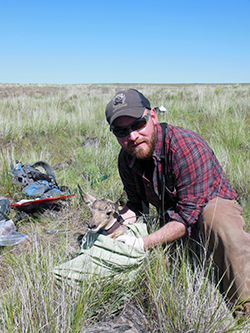
Pronghorn antelope (Antilocapra americana) were once one of the most numerous large mammals in California, with populations estimated to have been as high as 500,000 prior to the Gold Rush era. In the mid-1800s, pronghorn were nearly extirpated by market-shooting to feed California’s rapidly expanding human population.
The remaining population of pronghorn has long been understudied. Prior data collected on the species have been limited to herd counts and habitat selection. In recent years, there has been growing concern over pronghorn populations, particularly in northeastern California. During the harsh winter of 1992, the number of pronghorn dropped almost 50 percent to an estimated 5,000 individuals. The northeastern portion of the state currently supports a population of approximately 4,500 animals that occur primarily in Modoc, Lassen, Siskiyou and Shasta counties and has been fairly stable, with slow declines, since about 2000. The herd’s inability to rebound has prompted scientists to try to understand the specific conditions leading to the declines.
In 2016 the Institute for Wildlife Studies (IWS) completed a two-year study, with funding from CDFW’s Big Game Management Account, which explored aspects of the pronghorn population on the Modoc Plateau. The study involved 48 does (adult females) and 42 fawns that were radio-collared and followed until their deaths or the study’s end. The researcher’s objectives were to learn more about the pronghorn use of habitat, aspects of their reproduction and factors affecting survival of does and fawns.
The researchers found that for most of the year, pronghorn used open areas with less shrubby and more herbaceous vegetation within their sagebrush-steppe habitats. But during fawning, when does need to hide their young, they shifted to spending more time in areas with greater densities of shrubs and juniper trees. The annual survival rate for does in the study was 69 percent, which is low compared to other pronghorn populations. Mountain lions accounted for 80 percent of predator-related mortalities, most of which occurred during and just after the peak birthing period when does are most vulnerable. Fawn survival averaged 44 percent, a higher-than-typical figure, with unknown causes (37.5 percent) or suspected coyote predation (21 percent) accounting for most fawn mortalities.
The adults’ increased use of shrubby areas and conifer woodlands during fawning suggests an important factor in the population’s continued decline. Juniper woodlands have been encroaching on the sagebrush-steppe habitat in the Modoc Plateau for decades, and these juniper trees provide areas of concealment for ambush predators such as mountain lions. Most ungulate studies demonstrate that adult survival plays a more critical role in population stability than juvenile survival. CDFW may be able to reduce adult pronghorn mortality through habitat restoration – the removal of encroaching junipers could help to reduce predations by lions, and potentially increase the Modoc pronghorn population.
 Read complete report.
Read complete report.